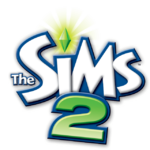- This guide is for the original PC game. For console versions, see The Sims 2 (console). For the PSP version, see The Sims 2 (PSP). For the Game Boy Advance version, see The Sims 2 (GBA). For the Nintendo DS version, see The Sims 2 (DS).
The Sims 2 is a strategic life simulation computer game developed by Maxis and published by Electronic Arts. It is the sequel to the best-selling computer game, The Sims, which debuted on February 4, 2000. Mark Mothersbaugh composed the music for the game.
The Sims 2 essentially revolves around the same concept as its predecessor. Players are free to control their Sims (as they interact with their virtual surroundings) engaging in various mundane activities and forming relationships in a manner similar to real life. Like its predecessor, The Sims does not have a defined final goal; gameplay is open-ended. Sims 2, however, has life goals, wants and fears, the fulfillment of which can produce both positive or negative outcomes. All Sims age, and can live over 100 Sim days depending on the degree of which their aspirations are fulfilled (although some items can extend a Sim's lifespan further).
The Sims 2 builds on its predecessor by allowing Sims, the simulated human characters, to age through six stages of life and incorporating a more powerful 3D graphics engine. It was first released on September 14, 2004 and became an instant success, having sold a then-record one million copies in its first ten days.In addition to its commercial success, The Sims 2 was well received by critics. As of July 26, 2007, The Sims 2 has sold more than 13 million units worldwide and is the best-selling PC game of 2004. A sequel, The Sims 3, was announced by EA in November 2006 and is scheduled for release in 2009. As of April 2008, The Sims 2 website celebrated 100 million copies of The Sims series sold. Template:Continue Nav
History
Development
EA Games announced on May 5, 2003 that the Maxis studio had begun development on The Sims 2. Will Wright admits that while most of the content of The Sims 2 are original ideas, inspiration for its own expansions and constituents spawned from the successes of the first game. The community interest in the antecedent The Sims 2: Pets expansion, and The Sims: Hot Date expansion ensured the creation of The Sims 2: Nightlife expansion.
After development concluded, designers from Maxis regarded The Sims 2 as very capricious during creation. Bugs would appear apparently spontaneously, and Sims would be "tweaked", or have anomalies not present in a previous run.
Controversy
The Sims 2 highly malleable content and open-ended customization have led to controversy on the subject of pay sites and sexual modifications. Custom content is distributed through independent websites, some of which charge for downloading materials. Some modifications, purportedly revealing sexual anatomy of the Sims, sparked legal controversy.
On July 22, 2005, Florida attorney Jack Thompson alleged that Electronic Arts and The Sims 2 promoted nudity through the use of a mod or a cheat code. The claim was made that pubic hair, labia and other genital details were visible once the "blur" (the pixelation that occurs when a Sim is using the toilet or is naked in the game) was removed. Electronic Arts issued a statement saying that when the censor was removed, Sims lack such anatomical definition, similar to Barbie and Ken dolls.
Prior to Thompson's statement, there was a cheat code which removed pixelation accessible from the console menu. Shortly after the statement, subsequent patches and expansion packs removed the "intProp censorGridSize" code.
Game customization
The Sims 2 is an extremely malleable game. Modders alter the game in ways as simple as creating a new floor texture of rocks or as complicated as writing entire patches for the game code to customize its behavior. Such modifications are all loosely referred to as "custom content." Specifically, custom content can be divided into four categories: exporting (creating Sims and lots in-game or using the game's included Body Shop and exporting them to a file), recoloring (creating a new texture for an object), meshing (creating an object or modifying its shape) and hacking (writing code that manipulates game and object behaviors).
The modding community for The Sims 2 is self-supporting, with more advanced modders writing tools and tutorials to help in creating custom content and modifying the game environment. The "Sims 2 Body Shop" is a program shipped with The Sims 2 that allows users to create custom clothing and body recolors, such as eyes, hair and skin tone. These custom created parts can be imported directly into the game, or can be uploaded onto the official The Sims 2 Exchange for other users to download and implement into their own games. Two elements that propagate customization are the official Sims 2 Exchange and the extensive network of fan sites that distribute custom content. More than 250,000 Sims and lots have been uploaded to the on the Official Site.
Table of Contents
- Walls
- Doors and Windows
- Flooring
- Wall Coverings
- Staircases
- Decks and Foundations
- Terrain
- Gardening
- Roofs
- Miscellaneous
- Small Appliances
- Large Appliances
- Entertainment
- TVs and Computers
- Audio
- Small Electronics
- Table Lamps
- Floor Lamps
- Wall Lamps
- Hanging Lamps
- Outdoor Lamps
- Miscellaneous
- Creativity
- Knowledge
- Exercise
- Recreation
- Dressers
- Children
- Party
- Miscellaneous
- Community Lot Only
- Aspiration Rewards
- Career Rewards
- Other Objects

